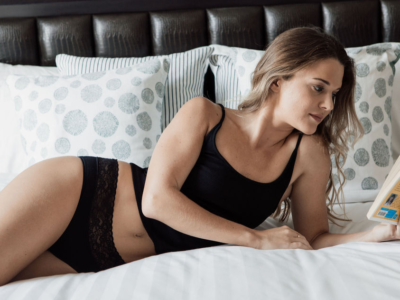Hands up, who hasn’t checked their breasts recently? When your to-do list is longer than Sheikh Zayed Road, self-care can end up getting pushed further and further down the list. And no one likes to think about the C word. But early detection saves lives, so make a resolution this Breast Cancer Awareness Month and commit to a monthly breast check.
Now, a breast check isn’t something you do once and then forget about. It’s not even just an annual affair. To really get to know your breasts and recognise if something isn’t quite right, you need to check your breasts regularly, ideally at around the same time every month. Breasts change during your menstrual cycle. They might feel a bit tender at certain times of the month, or lumpier than usual. So ideally, you want to check them just after your period has finished.
1. First off, make sure you’re not rushed for time and that the room is a comfortable temperature.
You might want to adjust the air con so you’re not shivering your way through your check.
2. Look at your breasts in the mirror, first with your arms by your sides and then with them raised.
- Do you notice anything unusual? You’re looking for:
- Changes to the shape of your breast
- Changes to your nipples. Does one look like it’s pointing in a slightly different direction than normal, or like it’s been pressed inwards?
- Puckering or dimpling to the skin, a dent or any other changes in how the skin looks
- Discolouration, particularly a rash or a red, moist area around your nipple that lasts more than a couple of days
- Any noticeable swelling around your breast, armpit or collarbone
It’s perfectly normal for one breast to be a bit bigger than the other, so that isn’t something to worry about unless one seems to have grown in size.
3. While standing up, lift your right arm above your head and feel your right breast with your left hand.
You want to check all around the breast, right into your armpit and up to your collarbone. Keep your fingers flat and together, rather than digging them into the tissue. This time, you’re checking for:
- Any new lumps
- Any areas where the breast feels thicker or just different to the other breast
- Differences in the texture of the skin, such as puckering, that you might not have seen in the mirror
4. Repeat with the other breast.
5. Lie down and repeat steps 3 and 4.
Sometimes lumps are not noticeable when standing up, so you need to follow the same technique while lying down. Using the same firm, flat touch, following a pattern to make sure you are feeling all of the breast tissue from your nipples to the outer edges of your breasts, not missing the area around your armpits and collarbone.
6. Set a reminder on your phone to check again next month.
In between checks, there are a few other things to keep an eye out for:
- Discharge or bleeding from your nipple
- Pain or discomfort in one breast or armpit that doesn’t go away, or that’s there most of the time




